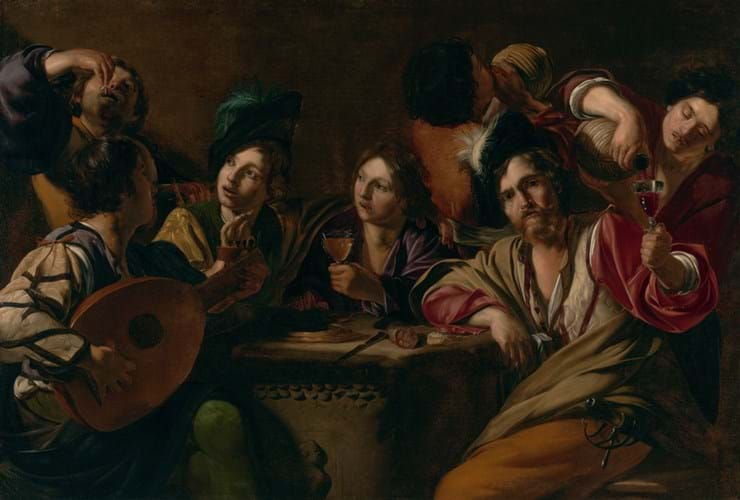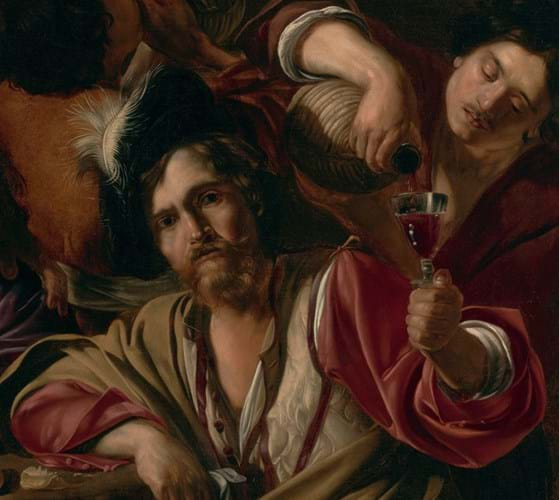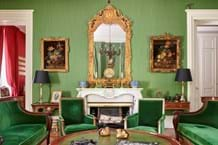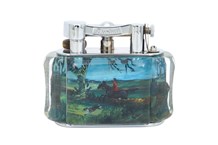
A Drinking and Musical Party by Bartolomeo Manfredi which has been acquired by the Getty Museum from a private collector.
As one of the leading “Caravaggisti” – the group of artists who emulated the style of Caravaggio (c.1571-1610) – Manfredi’s works were often confused with the latter’s in the decades after the great master’s death. A Drinking and Musical Party was among the works attributed to Caravaggio until the hand of Manfredi was identified by 20th century scholars.
Manfredi is now considered as arguably the most important and innovative of Caravaggio’s early followers. While few of his works have ever appeared at auction, the commercial prominence of the most sought Caravaggisti has since risen significantly in recent decades as the supply of masterworks has dried up.
Depicting a group of seven young men gathered around a table, the Getty’s 4ft 4in x 6ft 5in oil on canvas was last seen in public in 2017 in the Beyond Caravaggio exhibition at the National Gallery in London. It was part of the collection of Alvaro Saieh and Ana Guzmán (known as the Alana Collection, a combination of the couple’s forenames) who owned a number of Caravaggisti paintings.
It then appeared at Christie’s New York as part a group of 23 works from their collection offered in June 2022. The picture however was unsold against a hefty-looking $4m-6m estimate.
It is unclear whether it subsequently changed hands but the Getty said it had been recently acquired from a private collector.
Any work by Manfredi, especially of this scale and ambition, is a great rarity on the market. The highest price recorded for the artist at auction is the $550,000 (£385,896) for Christ Blessing that sold at Sotheby's New York in 2018 according to Artprice.com.
Hint of menace
The painting itself shows the seven figures eating, drinking and playing music. It ‘provides a fascinating glimpse into daily life in early-17th century Rome’ according to the Getty.
An elegantly dressed man plays a lute while, amid the merrymaking, two servants in the background appear to be stealing bread and wine. Among the other typically Caravaggesque elements are the exposed sword of the bearded man whose glass is being filled with wine and the knife on the table menacingly pointing towards the viewer – implying a heated brawl could break out at any moment.
The work is also characterised by a sumptuous palette and dramatic contrasts of light and shade, mimicking Caravaggio’s trademark use of chiaroscuro.
Trained in northern Italy, Manfredi later moved to Rome which is where he discovered the work of Caravaggio. He tended to favour large horizontal canvases and his work typically features tavern scenes with soldiers playing cards, fortune tellers and musicians playing instruments.
Intended for an open market of private collectors, his paintings were highly influential among foreign painters, particularly French, Dutch, and Flemish artists working in Rome at the time. In this way Manfredi made an important contribution to the widespread popularity of the Caravaggesque style across Europe.
Senior curator of paintings at the Getty Museum Davide Gasparotto said: “Although Manfredi was not properly a pupil of Caravaggio, his strikingly realistic depictions of genre scenes crucially contributed to the European success of the Caravaggesque movement.
“Since its reappearance in 1976, A Drinking and Musical Party has been considered one of Manfredi’s greatest paintings. Its addition to our collection represents a major coup that will allow us to display a picture that attained enormous success among collectors and amateurs in 17th century Europe.”
The Getty’s existing Caravaggisti paintings include Christ and the Adulteress by Valentin de Boulogne, The Supper at Emmaus by Bartolomeo Cavarozzi, and Christ Crowned with Thorns by Gerrit van Honthorst.
Following the acquisition, A Drinking and Musical Party went on view this week at the Getty Center’s East Pavilion.






